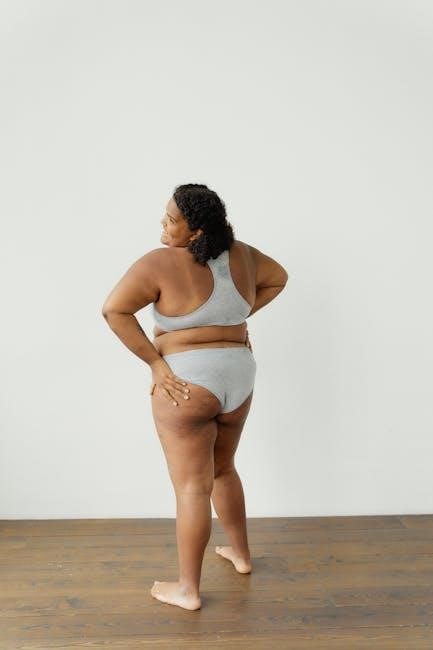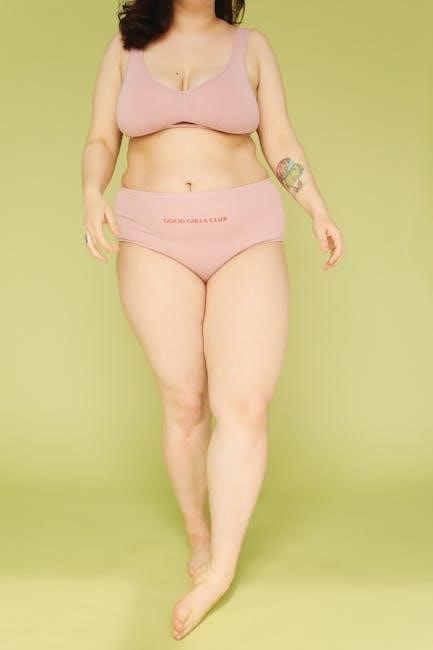Understanding underwear sizing is essential for comfort and confidence. This guide helps you navigate measurements, styles, and fits, ensuring the perfect pair for every body type and preference.
Why Understanding Underwear Sizes is Important
Understanding underwear sizes ensures optimal comfort, confidence, and health. Ill-fitting underwear can lead to discomfort, chafing, or even health issues like skin irritation. Proper sizing enhances mobility, especially during physical activities, and prevents wardrobe malfunctions. It also allows for better hygiene and breathability. With various styles and materials available, knowing your size helps you choose the most suitable option for your body type and lifestyle. Additionally, accurate sizing reduces the risk of returns or exchanges when shopping online. Taking the time to measure correctly guarantees a seamless and enjoyable experience, making it a crucial step in your daily wardrobe choices.
Key Factors to Consider When Choosing Underwear
When selecting underwear, consider your body type, lifestyle, and personal comfort. Fabric type is crucial, with options like cotton for breathability, moisture-wicking materials for active use, and silk for luxury. Style preferences vary, from boxers to briefs or trunks, each offering different support and coverage. Waist and hip measurements ensure a proper fit, while chest measurements matter for bras. Activity level impacts choices, with some styles designed for sports or everyday wear. Additionally, elasticity and stretch affect long-term comfort and durability, ensuring your underwear remains supportive and comfortable over time. These factors guide you to the best choice for your needs.

How to Measure Yourself for the Perfect Fit
Measure your waist at the natural line, hips at the widest point, and chest for bras, ensuring the tape is snug but not tight for accuracy.
Step-by-Step Guide to Measuring Your Waist
To measure your waist accurately, locate your natural waistline, typically around your belly button. Wrap a flexible tape measure snugly but not too tight. Ensure the tape is parallel to the floor and level all around. Take note of the measurement in inches or centimeters. This will help determine your size in underwear charts, ensuring a comfortable and proper fit. Always refer to the specific brand’s sizing guide, as measurements may vary slightly between brands.
How to Accurately Measure Your Hip Size
Measuring your hip size involves finding the widest part of your hips, typically about 7-9 inches below your waistline. Stand upright and wrap a flexible tape measure around this area, ensuring it’s level and not too tight. The measurement will help determine your underwear size, especially for styles that provide hip coverage. Accurate hip measurements ensure a comfortable fit and prevent issues like gapping or tightness. Always align this measurement with the brand’s size chart for the best results.
Understanding Chest Measurements for Men and Women
Chest measurements are crucial for determining the right underwear fit. For men, measure around the fullest part of the chest, keeping the tape level and snug. This helps in selecting styles like compression or athletic underwear. For women, the chest measurement often relates to bra size, influencing the choice of bras or lingerie. Accurate chest measurements ensure optimal support and comfort, especially for women with larger bust sizes. Always refer to specific brand size charts, as measurements may vary slightly between brands and styles.
Mens Underwear Size Guide
Men’s underwear sizes vary by style and brand. Measure waist and hips for accurate fit. Choose styles like boxers, briefs, or trunks based on comfort and activity level.
Waist Measurements for Men’s Underwear Sizes
Accurate waist measurements are crucial for selecting the right men’s underwear size. Measure around the natural waistline, typically just above the hipbone, ensuring the tape is snug but not tight. For most brands, waist sizes range from Small to 3XL, corresponding to specific inch measurements. For example, a Medium typically fits waists measuring 32-34 inches. Always refer to the brand’s size chart, as sizes can vary slightly between manufacturers. Proper fit ensures all-day comfort and prevents issues like digging or rolling; This step is essential for both casual and athletic underwear styles.
How to Choose the Right Style for Your Body Type
Selecting the right underwear style involves considering your body type and lifestyle. For lean builds, boxer briefs or briefs provide support and definition. Athletes may prefer trunks or performance briefs for moisture-wicking comfort. Larger frames benefit from boxer shorts for breathability and coverage. If you’re between sizes, opt for a slightly smaller size for a snug fit. Personal comfort and activity level should guide your choice, ensuring the underwear complements your daily needs without restricting movement. This approach ensures a flattering and functional fit tailored to your physique.
Mens Boxers, Briefs, and Trunks Size Charts
Mens underwear size charts vary by style, ensuring a tailored fit. Boxers typically use hip measurements, while briefs rely on waist sizes. Trunks combine both for a snug fit. Size charts often range from XS to 3XL, with waist measurements spanning 28-50 inches. Hip measurements for boxers usually range from 36-44 inches. Fabric type and stretch also influence fit. Use a flexible tape measure for accurate sizing. Consider activity level and personal comfort when selecting styles. Proper fit enhances comfort and durability, making size charts a crucial tool for choosing the right underwear. Always refer to brand-specific guides for accuracy.
Womens Underwear Size Guide
Womens underwear size guide helps determine the perfect fit using waist and hip measurements, ensuring comfort and support for various body types, styles, and different fabric preferences.
Waist and Hip Measurements for Women’s Underwear
Accurate waist and hip measurements are crucial for selecting the right womens underwear size. Measure your natural waistline and fullest hip point to determine your size. For example, a waist of 64-69 cm and hips of 78-83 cm typically correspond to a small size. Refer to size charts, which often provide ranges for waist and hip circumferences. Ensure the fit is comfortable, as tight underwear can cause discomfort. If your measurements fall between sizes, consider sizing up for a more relaxed fit. This ensures optimal comfort and support throughout the day.
How to Select the Best Style for Your Figure
Selecting the best underwear style for your figure involves considering your body type, lifestyle, and personal comfort preferences. For curvier figures, high-waisted styles or those with more coverage can provide a flattering and supportive fit. Petite frames may benefit from seamless or minimalistic designs to avoid overwhelming the silhouette. If you have an athletic build, consider styles that offer a snug fit without restriction.Fabric choice also plays a role; breathable materials like cotton are ideal for everyday wear, while lace can add a decorative touch. Assessing your activity level helps determine the need for supportive features, ensuring the underwear stays in place during movement. Additionally, matching the style to the occasion—such as seamless options for tight clothing—enhances both comfort and appearance. By aligning these factors with your body type, you can find a style that boosts confidence and ensures all-day comfort.
Womens Lingerie Size Charts Explained
Women’s lingerie size charts are designed to help you find the perfect fit based on body measurements. Sizes typically range from XS to XL, with measurements for chest, waist, and hips. For example, a size S might correspond to a chest circumference of 83-88 cm and a waist of 69-74 cm. Cup sizes (A-E) are also considered, ensuring proper support and comfort. When selecting lingerie, compare your measurements to the chart to determine the best fit. Keep in mind that sizes may vary slightly between brands, so always refer to the specific brand’s guide for accuracy.
Plus Size Underwear Guide
This guide helps plus-size individuals find comfortable, flattering underwear. It covers sizing tips, style recommendations, and how to navigate size charts for the best fit and confidence.
Plus Size Measurement Tips for a Comfortable Fit
Accurate measurements are key to finding comfortable plus-size underwear; Stand upright and measure your natural waistline and hip circumference using a flexible tape measure. Ensure the tape isn’t too tight or loose. Consider your body shape and fabric stretch when selecting sizes. Opt for breathable, stretchy materials for all-day comfort. If between sizes, size up for a relaxed fit. Consult brand-specific size charts, as fits may vary. Proper fit ensures confidence and ease, making everyday wear enjoyable and supportive;
How to Navigate Plus Size Underwear Size Charts
Navigating plus-size underwear size charts requires attention to detail. Start by aligning your waist and hip measurements with the chart, ensuring accuracy for the best fit. Note that some brands use numerical sizing, while others rely on traditional sizes like XL or 3XL. Fabric stretch and style can influence fit, so consider these factors. If unsure, compare your measurements to the chart’s guidelines, as sizes may vary between brands. Look for features like high-cut legs or wider waistbands for added comfort. Reading reviews can also provide insights into how a style fits in real life. Don’t hesitate to reach out to customer service for clarification if needed.
Best Styles for Plus Size Bodies
When choosing underwear for plus-size bodies, comfort and support are key. High-cut leg styles and wide waistbands provide a flattering fit without digging into the skin. Boxer briefs and boyshorts are excellent options, offering full coverage and a seamless look under clothing. Soft, breathable fabrics like bamboo or modal are ideal for all-day wear. Moisture-wicking materials are great for active lifestyles, keeping you dry and comfortable. Look for styles with minimal seams to avoid chafing and adjustable straps for a secure fit. These features ensure confidence and comfort, making them perfect for everyday wear.
Underwear Size Charts by Style
Underwear size charts vary by style, with boxer briefs, briefs, and trunks offering unique fits. Each style has specific measurements, ensuring comfort and a tailored look for all body types.
Boxer Briefs Size Guide
Boxer briefs combine the breathability of boxers with the snug fit of briefs. To find your size, measure your waist and hip circumference. Most brands offer sizes from XS to 3XL, with waist measurements ranging from 28-50 inches. Inseam lengths typically vary between 5-9 inches, offering mid-thigh coverage. Ensure a comfortable fit by matching your measurements to the size chart. Consider your activity level and fabric type, as stretch and compression can affect sizing. Proper fit ensures all-day comfort and support, making boxer briefs a versatile choice for various body types and preferences.
Briefs Size Chart and Fitting Tips
Briefs offer a classic, supportive fit with a snug design. To determine your size, measure your natural waistline and hip circumference. Briefs typically range from XS to 3XL, with waist measurements from 28-50 inches. Ensure the waistband sits comfortably without digging into your skin. Proper fit is key for all-day comfort. Consider your hip size to avoid gaps and ensure a seamless look under clothing. Pairing the right size with your body type ensures maximum support and a flattering fit, making briefs a timeless choice for everyday wear and versatility.
Trunks Size Guide and Measurement Instructions
Trunks combine comfort and style, offering a mid-thigh length. Measure your waist and hips for accuracy. Sizes typically range from S to 3XL, with waist measurements from 28-50 inches. Ensure the waistband fits snugly but not too tight. The inseam usually ranges from 5-9 inches, providing coverage without bunching. Proper fit ensures all-day comfort and a streamlined look. Trunks are versatile for both casual and active wear, making them a popular choice for their balance of support and style.

Factors Affecting Underwear Fit
Fabric type, waist and hip measurements, and elasticity impact underwear fit. Ensuring the right size enhances comfort and prevents issues like rolling or chafing throughout the day.
Fabric Type and Its Impact on Sizing
Fabric type significantly influences underwear fit and comfort. Stretchy materials like spandex provide flexibility, while cotton offers breathability. Thicker fabrics may require larger sizes for a seamless fit. Synthetic blends, such as polyester, offer durability but may retain heat. Luxury fabrics like silk or bamboo prioritize softness. Understanding fabric properties helps in selecting the right size, ensuring optimal comfort. Always consider fabric type when choosing underwear to avoid tightness or looseness. Proper fit enhances daily wearability and satisfaction.
How Activity Level Affects Underwear Choice
Your activity level plays a crucial role in selecting the right underwear. High-intensity exercises require moisture-wicking, breathable fabrics to prevent chafing and discomfort. For active individuals, seamless designs and four-way stretch materials are ideal. Everyday wear may prefer soft, breathable cotton for comfort. Light activities can opt for a blend of comfort and support. Always choose underwear that aligns with your lifestyle to ensure all-day comfort and performance. The right fabric and style can enhance your activity experience, keeping you confident and comfortable throughout.
The Role of Elastic and Stretch in Fit
Elastic and stretch are critical for a comfortable and flattering fit in underwear. High-quality elastic waistbands provide secure support without digging or rolling. Stretch fabrics, such as spandex blends, allow for a full range of motion while maintaining shape. Seamless designs minimize chafing, ensuring smooth comfort. Proper elasticity ensures the underwear stays in place without feeling restrictive. For active lifestyles, increased stretch is essential to accommodate movement. Choosing the right balance of elasticity and structure is key to achieving both comfort and durability in your underwear.

Tips for Choosing the Right Underwear
Consider fabric, fit, and lifestyle needs. Prioritize comfort and support while ensuring the style complements your body type. Always refer to size charts for accuracy.
How to Avoid Common Sizing Mistakes
To ensure the best fit, measure yourself accurately and regularly, as sizes can vary between brands. Don’t rely on past purchases, as sizes may change over time. Always refer to the specific brand’s size chart, as there’s no universal standard. Avoid guessing your size—use a tape measure for precise waist, hip, and chest measurements. If unsure, size up for comfort. Consider fabric stretch and activity level when choosing styles. Double-check size guides for specific products, like boxer briefs or shapewear, to avoid mismatches. For gifts, ask for sizes discreetly or opt for adjustable styles.
Understanding the Difference Between Sizes Across Brands
Underwear sizes can vary significantly between brands due to differing measurement standards and fit philosophies. Some brands use numerical sizing, while others rely on traditional labels like small, medium, and large. Fabric type and stretch also impact how sizes fit. Always consult the specific brand’s size chart, as a medium in one brand may fit like a large in another. Pay attention to body measurements provided in charts to ensure accuracy. Don’t assume consistency across brands—check each one individually for the best fit. This variation emphasizes the importance of referencing each brand’s guidelines carefully.
When to Size Up or Down for Comfort
Deciding whether to size up or down for comfort depends on personal preference, activity level, and fabric type. If you prioritize breathability and a looser fit, consider sizing up. For a snug, supportive feel, sizing down might be better. However, ensure the fit isn’t restrictive. If you’re between sizes, opt for the one that allows ease of movement. Some fabrics, like stretchy materials, may accommodate slight size adjustments without sacrificing comfort. Always consult the brand’s size chart and consider reviews for insights into how others find the fit. Balancing comfort and support is key to making the right choice.
Specialized Underwear Size Guides
Specialized underwear, like period or maternity styles, requires precise measurements for comfort and function. Each design is tailored to specific needs, ensuring a secure and comfortable fit.
Period Underwear Size Guide
Period underwear sizing focuses on comfort and leak protection. Measure your natural waist and hips to ensure a secure fit. Styles vary, so choose based on flow and activity level. Brands like Saalt offer inclusive sizing, while others provide detailed charts. Accurate measurements are key for optimal performance. Consider both waist and hip circumferences to avoid gaps or tightness. Styles range from high-waisted to bikini cuts, catering to different preferences. Always check the brand’s specific size guide, as sizing may vary. Proper fit ensures confidence and comfort during your cycle.
Shapewear Size Chart and Fitting Tips
Shapewear sizing requires precise measurements for effective smoothing and support. Measure your natural waist, hips, and bust to find your size. Look for charts that correlate these measurements to ensure a snug yet comfortable fit. High-compression styles may run smaller, so consider sizing up for comfort. Choose styles that target your specific needs, like tummy control or thigh slimming. Proper fit prevents rolling or digging, ensuring all-day wearability. Refer to brand-specific guides, as sizing can vary. The right fit enhances your silhouette without sacrificing comfort or mobility.
Maternity Underwear Size Guide
Maternity underwear sizing focuses on comfort and support during pregnancy. Measure your waist and hips to determine your size, as sizes often align with pre-pregnancy measurements. Look for stretchy, breathable fabrics that accommodate growth. High-waisted styles provide additional belly support, while seamless designs reduce irritation. Size charts may vary by brand, so refer to specific guides. Ensure a snug fit to prevent rolling or digging. Opt for adjustable waistbands for flexibility as your body changes. The right maternity underwear balances comfort, support, and style, ensuring confidence throughout your pregnancy journey.

Underwear as a Gift: A Size Guide
Gifting underwear? Ensure a perfect fit by knowing their size. Consider style preferences and occasion for a thoughtful, personal touch that feels just right.
How to Choose the Right Size Without Knowing Measurements
When gifting underwear without knowing measurements, consider the recipient’s clothing size as a starting point. Look for styles with stretch or adjustable features for a more forgiving fit. Check size charts from the brand to ensure accuracy. Think about their lifestyle—active individuals may prefer moisture-wicking fabrics. Opt for neutral colors or patterns to suit their taste. If unsure, select a popular style like boxer briefs or boyshorts, which are versatile. Reading reviews can also provide insights into fit and comfort. Remember, it’s the thought that counts, so focus on quality and comfort.
Popular Styles for Gifting
When gifting underwear, popular styles include boxer briefs, boyshorts, and seamless options due to their versatility and comfort. Boxer briefs are a classic choice, suitable for most body types, while boyshorts offer a stylish yet practical option. For those seeking functionality, shapewear or period underwear are trendy and appreciated. Brands like Parade and Saalt are favored for their inclusive sizing and soft fabrics. Consider the recipient’s lifestyle—sporty, elegant, or eco-friendly options. Always check size guides to ensure the best fit, guaranteeing comfort and confidence for the wearer.
Tips for Buying Underwear as a Gift
Buying underwear as a gift can be thoughtful if done correctly. Consider the recipient’s style preferences and comfort needs. Opt for neutral or timeless colors like black, white, or pastels. Ensure to check size charts, as sizes vary across brands. Packaging and presentation matter—choose sets or individually wrapped pairs. If unsure about size, select a gift card. Focus on quality fabrics like cotton or bamboo for breathability. Avoid overly bold designs unless the recipient prefers them. Personalize the gift with a heartfelt note to make it extra special and show you care about their comfort and style.
Underwear Care and Maintenance
Proper care extends underwear lifespan. Wash in cold water, avoid bleach, and air-dry to preserve elasticity. Store in a cool, dry place to maintain shape and quality.
Washing Guide for Different Fabric Types
Proper washing ensures longevity and comfort. For cotton underwear, use cold water and mild detergent to prevent shrinkage. Polyester blends can withstand machine washing but benefit from gentle cycles. Delicates like lace or silk should be hand-washed in cold water with a soft detergent. Bamboo fabrics prefer eco-friendly detergents to maintain their softness. Avoid bleach, as it can weaken fibers and cause discoloration. Fabric softeners should also be avoided, as they can reduce moisture-wicking properties in performance fabrics. Always turn underwear inside out before washing to protect the outer layer. Air-drying is recommended to preserve elasticity and prevent wear from heat. Check care labels for specific instructions, as some fabrics may require special attention. By following these guidelines, you can maintain the quality and fit of your underwear while keeping them clean and hygienic.
How to Extend the Life of Your Underwear
To extend the life of your underwear, proper care is essential. Wash items in cold water using a gentle detergent to avoid fabric degradation. Avoid using bleach or fabric softeners, as they can weaken elastic and damage materials. Turn underwear inside out before washing to protect the outer layer from friction. Air-drying is recommended, as heat from dryers can shrink or stretch fabrics. Store underwear in a cool, dry place, folded or rolled to prevent stretching. Avoid overloading your washing machine, as excessive friction can cause wear. Regularly cleaning and storing your underwear correctly ensures a longer lifespan and maintained comfort.
Storage Tips to Maintain Fit and Quality
Proper storage is key to maintaining the fit and quality of your underwear. Store them in a cool, dry place away from direct sunlight to prevent fading and fabric degradation. Use breathable materials like cotton or mesh drawers to allow airflow, reducing moisture buildup. Avoid overcrowding your drawer, as this can cause stretching or misshaping. Fold or roll your underwear gently to prevent creases and damage to elastic. For delicate or special-care items, consider separate compartments to protect them from friction. Keeping your underwear organized and stored correctly ensures lasting comfort and quality.


